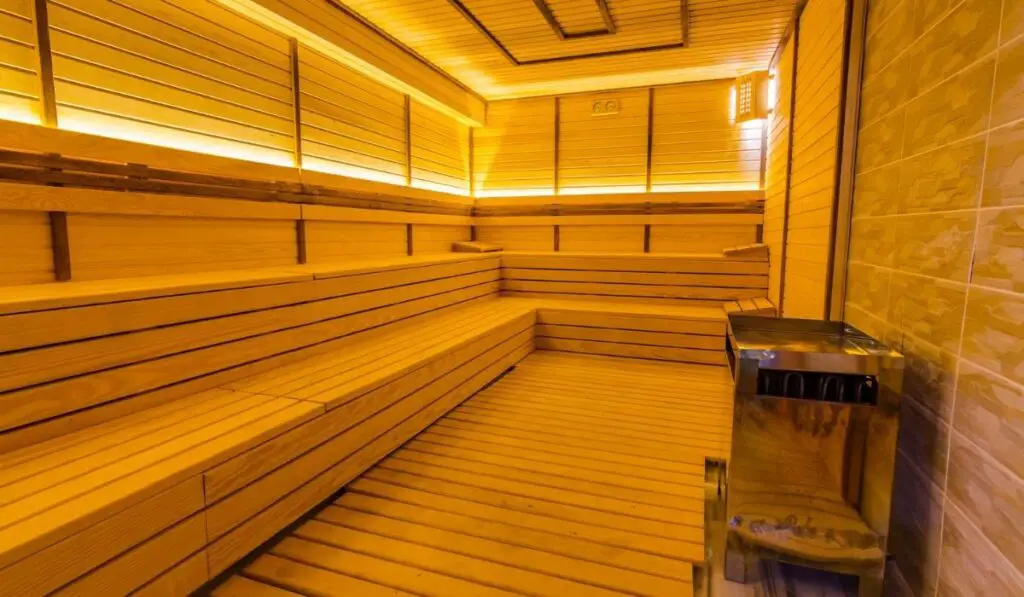Owning a sauna and having easy access to it inside (or outside) your home is the most convenient way to enjoy all the benefits they provide. If you’re considering getting a sauna for your home or if you already have one, you might be thinking about where all the steam goes after the sauna cools down. Do saunas need a floor drain to get rid of excess water?
Typically saunas don’t need a floor drain; the steam in the sauna usually evaporates. Besides steam, there’s no big water source unless you bring water to clean it. Saunas don’t usually come with drains, but you can DIY add one to your existing sauna if you decide you really need a drain.
There can be a lot of steam in the sauna if you or other occupants are throwing lots of water on the sauna rocks, however, saunas are typically very dry (low humidity) and don’t hold much excess moisture that would require drainage. Even with the steam from the hot rocks, that usually evaporates in a matter of minutes. Continue reading this guide to learn why you might want a drain in your sauna and why most don’t need one.
When You May Need a Sauna Floor Drain

Saunas produce dry heat, with humidity ranging from 5-30% (measure the humidity with this hygrometer on Amazon). With such a low amount of moisture, a drain isn’t necessary. However, you might want a drain for convenience purposes including for things like the ability to rinse off inside the sauna, for cleaning the sauna by hosing it off, and also for when water is getting splashed around via the bucket and ladle.
Again, a drain is not needed most of the time, and if you buy a sauna kit like this one on Amazon, it likely will not come with one. If you want one, you will have to install it or hire a professional. Sauna drains are difficult to install because you have to pitch the floor towards the drain so that any water naturally flows down into it.
Why Most Saunas Don’t Need Drains
The reason why most saunas don’t need drains is simple – saunas do not produce a lot of water. In fact, they are quite the opposite of having lots of water; they are very dry (5-30% humidity). Since there isn’t really any water created in a sauna, why have a drain (besides for the convenience purposes listed in the previous section)?
Some of the only ways that water gets into the sauna is from sweat, water from the bucket and ladle if you’ve chosen to include one, as well as the water bottles from which you drink. Oftentimes, saunas are built beside pools so pool water is another potential source.
Either way, neither of these sources produces significant amounts of water in the sauna. Even if you ladle the whole bucket of water onto the sauna rocks, it will all flash to steam and eventually evaporate. Additionally, the sweat from the people in the sauna will evaporate as well or get absorbed by their towels or clothing.
As you can see, there is very little chance for standing water in a sauna unless you wish to hose off the inside and even if someone comes in from the pool, it’s not like there is enough water on the average person’s body to bring that much water in any way.
Can You Add a Drain to a Sauna?
Whether you can add a drain to a sauna or not depends on the brand, model, and type of sauna you have (more on the kinds in our guide). If you want a drain in your sauna, there are drain kits available for you to use. Additionally, you can pitch your own floor in your sauna to install a drain yourself. In either case, a floor drain installation inside a sauna is a tricky and time-consuming endeavor.
Drains in saunas can undoubtedly be helpful. For example, it would be difficult and time-consuming to clean if you have a large outdoor sauna. However, if you had a floor drain, you could easily wash down the interior with a hose and brush.
The addition of a floor drain could turn a lengthy, painstaking task into a fun, fast one. The best ways you can add a drain to the floor in your sauna is by using the bicycle spoke floor draining method as well as the ben square floor draining method. Let’s unwrap these terms (by the way, we have a guide on how to clean saunas as well):
- Bicycle spoke floor drain method – sleepers are placed with a sloping height towards the drain in a spoke pattern
- Ben square floor drain method – sleepers are placed in concentric squares with decreasing height towards the location of the drain
With both methods, the sleepers, narrow pieces of wood with various thicknesses, are used to angle the floor towards the drain. Once the sleepers are installed, dura rock is screwed down on top of them, covering the entire floor (minus the drain hole). Then the floor is sealed with vinyl cement.
For best results, use premium cement to fill the areas between the concentric square sleepers, in the ben square method, or the spokes in the bicycle spoke method. This fills all the gaps between the sleepers and provides a solid floor. The sleepers can then be used as a trowel guide to give the floor a nice, smooth finish.
